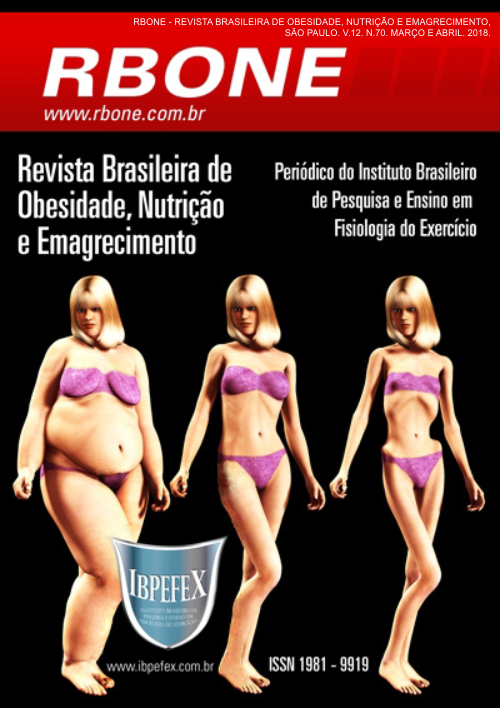Consumption of food groups in adults with overweight
Abstract
Introduction: Obesity is defined as a chronic disease, characterized by the excessive accumulation of adipose tissue, food consumption is directly related to excessive weight gain. Objective: To evaluate the consumption of food groups in overweight subjects. Methods: This cross-sectional study was attended by 102 adult individuals. Were submitted to anthropometric and later allocated in two groups: eutrophic (n = 43) and overweight (n = 59). Food intake was assessed by two 24-h recalls. The foods and preparations consumed were processed into portions and distributed into eight food groups according to the food pyramid. Data were analyzed using the chi-square test and Mann Whitney test (α = 5%). Results: Among the participants, 42.2% were eutrophic and 57.8% overweight. The majority were female sex (n=82), with low income (41.17%) and low education level. The food consumption was lower than recommended by food pyramid and there was no difference in portion consumption among the groups of individuals. Discussion: The population studied presented a high percentage of overweight, a nutritional profile that is increasing vertiginously among Brazilian adults. The consumption of food groups was inadequate, the fruit group was the one that most approached the recommended portion and the dairy products were highlighted for the low consumption among the overweight individuals. Conclusion: Individuals presented inadequacy in the consumption of food groups, regardless of nutritional status, with little food variation.
References
-ABESO. Associação Brasileira para o Estudo da Obesidade e da Síndrome Metabólica. Diretrizes brasileiras de obesidade 2016. 4ªedição. São Paulo. São Paulo. 2016.
-Anestis, D.; Christopher, K.R.; Givens, I.D.; Elwood, P.C.; Minihane, A.M. Associations between dairy consumption and body weight: a review of the evidence and underlying mechanisms. Nutrition Research Reviews. Vol. 24. 2011. p. 72-95. DOI: 10.1017/S095442241000034X.
-Avelino, G.F.; Previdelli, A.N.; Castro, M.A.; Marchioni, D.M.L.; Fisberg, R.M. Sub-relato da ingestão energética e fatores associados em estudo de base populacional. Cad Saúde Pública. Vol. 30. Num. 3. 2014. p. 663-668.
-Dias, P.S.; Brito, J.A.S.; Costa, A.P. Influência da condição socioeconômica no comportamento alimentar de universitários do sexo masculino. Revista eletrônica de administração e turismo. Vol. 8. Num. 4. 2016.
-IBGE,Instituto Brasileiro de Geografia e Estatística. Pesquisa de orçamentos familiares 2008-2009, POF: análise do consumo alimentar pessoal no Brasil. Rio de Janeiro. 2010.
-Kristensen, M.; Juul, S.R.; Sørensen, K.V.; Lorenzen, J.K.; Astrup, A. Supplementation with dairy calcium and/or flaxseed fibers in conjunction with orlistat augments fecal fat excretion without altering ratings of gastrointestinal comfort. Nutri Metabo. Vol. 7. 2017. p. 14-13.
-Lenthe, F.J.V.; Jansen, T.; Kamphuis, C.B.M. Understanding socio-economic inequalities in food choice behaviour: can Maslow’s pyramid help? British Journal of Nutrition. Vol. 113. p. 1139-1147. 2015.
-Lohman, T. G.; Roche, A. F.; Martorell, R. Anthropometric standardization reference manual. Champaign: Human Kinetics, 1988.
-Ministério da Saúde (MS). Guia Alimentar Para a População Brasileira. 2ªedição. Brasília-DF. 2014. Disponível em: <http://portalsaude.saude.gov.br/images/pdf/2014/novembro/05/Guia-Alimentar-para-a-pop-brasiliera-Miolo-PDF-Internet.pdf>.
-Ministério da Saúde (MS). Secretaria de Vigilância em Saúde. VIGITEL Brasil 2015: Vigilância de fatores de risco e proteção para doenças crônicas por inquérito telefônico. Brasília: MS, 2016. Disponível em: <https://www.endocrino.org.br/media/uploads/PDFs/vigitel.pdf>.
-Oliveira, D.C. Sociologia da obesidade. São Paulo: Resenhas book reviews. Editora Senac. 2017. DOI: 10.1590/1413-81232017222.24932015
-Philippi, S. T. Redesenho da Pirâmide Alimentar Brasileira para uma alimentação saudável.2013.
-Rossi, L.; Hayashi, A.P.T.; Solis, M.Y.; Lugaresi, R.; Almeida, N.; Szarfarc, S.C.; Philippi, S.T. Avaliação qualitativa e quantitativa do consumo alimentar de mulheres fisicamente ativas. Revista O Mundo da Saúde. Vol. 35. Num. 2. 2011. p. 179-184.
-Silva, P.M.C.; Cabral, J.C.R.; Vasconcelos, C.M.L. Ingestão do cálcio na obesidade de mulheres atendidas pelo Sistema Único de Saúde. Rev Nutr. Vol. 23. Num. 3. 2010. p. 357-367.
-Skowronska, J.E.; Jaworski, M.; Lorenc, R.; Karbownik, L.M.; Lewinski, A. Low dair calcium intake is associated with overweight and elevated blood pressure in Polish adult, notably in premenopausal women. PublicHealth Nutrition. Vol. 20. Num. 4. 2017. p. 630-637.
-Souza, J. B.; Enes, C.C. Influência do consumo alimentar sobre o estado nutricional de adolescentes de Sorocaba-SP. J Health Sci Inst. Vol. 31. 2013. p. 65-70.
-Tardido, A. F. M.; Falcão, M. C. O impacto da modernização na transição nutricional e obesidade. Revista Brasileira Nutrição Clínica. Vol. 21. 2006. p. 117-124.
-World Health Organization. Obesity: preventing and managing the global epidemic. Report of a World Health Organization Consultation. Geneva: World Health Organization. WHO Obesity Technical Report Series. Geneva. Num. 284. p. 256. 2000.
Authors who publish in this journal agree to the following terms:
- Authors retain the copyright and grant the journal the right of first publication, with work simultaneously licensed under the Creative Commons Attribution License BY-NC which allows the sharing of the work with acknowledgment of the authorship of the work and initial publication in this journal.
- Authors are authorized to enter into additional contracts separately for non-exclusive distribution of the version of the work published in this journal (eg, publishing in institutional repository or book chapter), with acknowledgment of authorship and initial publication in this journal.
- Authors are allowed and encouraged to post and distribute their work online (eg, in institutional repositories or on their personal page) at any point before or during the editorial process, as this can bring about productive change as well as increase impact and impact. citation of published work (See The Effect of Free Access).






